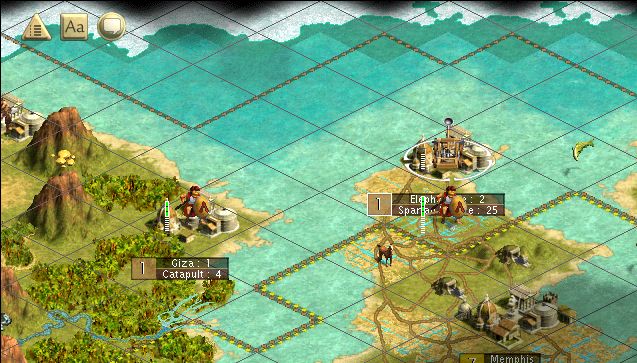My first post. My first QSC submission.
I have been lurking here for a few months learning lots from you guys. Thanks. :worshp:
Having completed my QSC and thought I had done fairly well until I saw how fast some others had grown. I still have a lot to learn.
I expected that the Great Lighthouse would be a major factor in this game which somewhat influenced my decision to found on the coast.
I built a granary before settler - probably a mistake in this situation.
2630BC Utica founded.
1790BC Leptis Magna founded.
1350BC Lighthouse complete in Carthage.
1000BC Contact the Egyptians.
I didn't note which of map making or code of law I traded to Egypt for all her gold and tech
(Bronze working, The wheel, Warrior code, and Cermonial burial).
I may have messed up by giving map making. Either that or she learned it soon afterwards because she founded a few cities on offshore islands that I had my eye on.
875BC Hippo Founded.
610BC Leptis Minor Founded.
470BC Sabratha founded.
430BC Rusicade founded.
310AD Oea founded.
290BC Hadrumetum founded.
210BC Cirta founded on beside Iron on island East of Egypt to keep swords away from Egypt.
250AD Declare war on Egypt.
320AD Nora founded.
400AD Golden age triggered by hoplite.
590AD Egypt eliminated.
I was reasonably happy with the war against Egypt. The biggest upset was losing a stack of units that were recovering when Thebes flipped back in one turn.
I lost very little in other flips. Anything that flipped was recaptured the next turn. I was in republic during the war and although I was experiencing some war weariness I wanted to eliminate Egypt to avoid losing ground to flips. I kept all cities I captured. I figured that If I could eliminate her it would have been a waste to raze the cities. (I did move a city by one tile later in the game).
I got no great leaders. I popped two huts on the
island west of Egypt homeland got barbs both times. I didn't see any other huts.
I tamed two volcanos (Mt. Etna and Mt. Vesuvious). It looks like Egypt got another because one of the workers I captured from her was an eq-worker. I didn't know what to expect from the first volcano (Mt. Etna) so I sent about six warriors to tame it. In fact the volcanos were no problem.
I only saw two squid. I killed one and avoided the other. I had no problem with the fog, except that it slowed down my contact with Egypt. I just made contact in 1000BC. I had one galley redlined but lost none. I used the fog to promote my galleys to help eliminate any Egyptian galleys I saw during the war. (I did lose one galley to Egypt).
I have been lurking here for a few months learning lots from you guys. Thanks. :worshp:
Having completed my QSC and thought I had done fairly well until I saw how fast some others had grown. I still have a lot to learn.
I expected that the Great Lighthouse would be a major factor in this game which somewhat influenced my decision to found on the coast.
I built a granary before settler - probably a mistake in this situation.
2630BC Utica founded.
1790BC Leptis Magna founded.
1350BC Lighthouse complete in Carthage.
1000BC Contact the Egyptians.
I didn't note which of map making or code of law I traded to Egypt for all her gold and tech
(Bronze working, The wheel, Warrior code, and Cermonial burial).
I may have messed up by giving map making. Either that or she learned it soon afterwards because she founded a few cities on offshore islands that I had my eye on.
875BC Hippo Founded.
610BC Leptis Minor Founded.
470BC Sabratha founded.
430BC Rusicade founded.
310AD Oea founded.
290BC Hadrumetum founded.
210BC Cirta founded on beside Iron on island East of Egypt to keep swords away from Egypt.
250AD Declare war on Egypt.
320AD Nora founded.
400AD Golden age triggered by hoplite.
590AD Egypt eliminated.
I was reasonably happy with the war against Egypt. The biggest upset was losing a stack of units that were recovering when Thebes flipped back in one turn.
I lost very little in other flips. Anything that flipped was recaptured the next turn. I was in republic during the war and although I was experiencing some war weariness I wanted to eliminate Egypt to avoid losing ground to flips. I kept all cities I captured. I figured that If I could eliminate her it would have been a waste to raze the cities. (I did move a city by one tile later in the game).
I got no great leaders. I popped two huts on the
island west of Egypt homeland got barbs both times. I didn't see any other huts.
I tamed two volcanos (Mt. Etna and Mt. Vesuvious). It looks like Egypt got another because one of the workers I captured from her was an eq-worker. I didn't know what to expect from the first volcano (Mt. Etna) so I sent about six warriors to tame it. In fact the volcanos were no problem.
I only saw two squid. I killed one and avoided the other. I had no problem with the fog, except that it slowed down my contact with Egypt. I just made contact in 1000BC. I had one galley redlined but lost none. I used the fog to promote my galleys to help eliminate any Egyptian galleys I saw during the war. (I did lose one galley to Egypt).





 . Might have been an error. OTOH, mm and tile shuffling between Carthage and Utica often saved a turn and/or gave some extra food and/or commerce.
. Might have been an error. OTOH, mm and tile shuffling between Carthage and Utica often saved a turn and/or gave some extra food and/or commerce.


